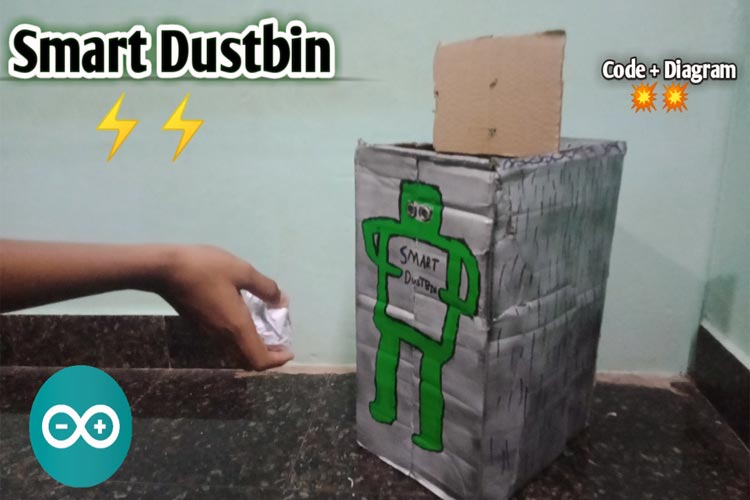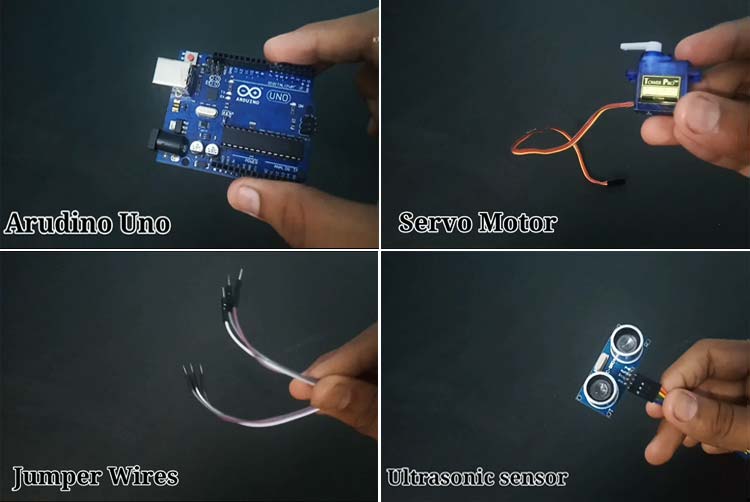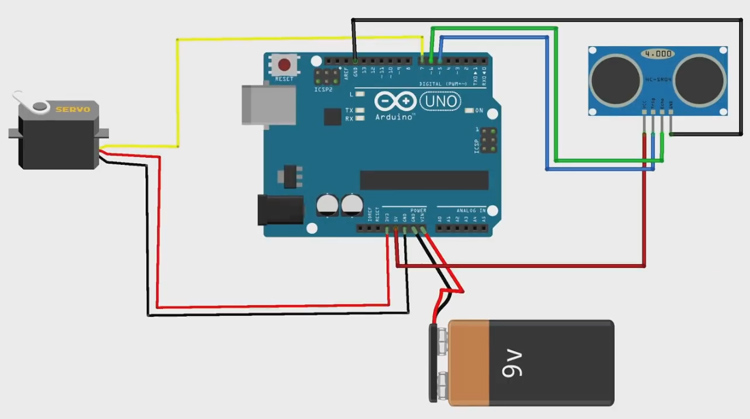
Smart Dustbin as its name represents its work smartly or we can say that it is an automatic dustbin. Smart Dustbin is a very good project from the Arduino. We can say that It is a decent gadget to make your home clean and attractive. kids spread trash to a great extent by paper, rappers and numerous different things at home. They will have fun with this dustbin they play with the dustbin and in the play of them, they clean your home as well because every time they use the smart Dustbin and it attracts the kids. They generally will be utilized to throw all trash and waste into this smart dustbin. if your hands are full of trash or junk and you're unable to open it manually this can be used. As it opens automatically without touching, this can help to control the spread of Coronavirus and even mosquitoes will not move around it so that it helps from preventing the spread of new diseases. Previously, We have also built IoT Based Dumpster Monitoring using ESP8266 and IoT Smart Dustbin using NodeMCU.
Table of Contents
Component Requirement for Arduino Based Dustbin
The following are the components required to build a smart dustbin using Arduino.

Project Used Hardware
Arduino UNO,
Jumper Wires,
Servo Motor,
Ultrasonic Sensor
Project Used Software
Arduino IDE
Project Hardware Software Selection
Arduino UNO: As you know that Arduino is a microcontroller-based open source electronic prototyping board that can be programmed with an easy-to-use Arduino IDE. The UNO is one of the most popular boards in Arduino family and a great choice for beginners.
Ultrasonic Sensor: These are the sensor that use ultrasonic waves to detect objects or to measure the distance between themselves and the object
Servo Motor: This is an electrical device that can push or pull and also rotate an object with great precision. if you want to rotate an object at some specific angles or distance, then you use servo motor. It is made up of a simple motor that runs through a servo mechanism. We can get a very high torque servo motor in a small and light weight packages.
Block Diagram
The working of this Arduino smart dustbin is very simple. The ultrasonic sensor acts as the input and the servo motor acts as the output, the Arduino UNO microcontroller is the main brain behind the project. The block diagram for Arduino smart dustbin is shown below

As shown in the block diagram, the Arduino microcontroller constantly monitors the values from the ultrasonic sensor which is placed outside the dustbin. When a person comes near the dustbin the values from the sensor change, this change is noticed by the microcontroller, and it then turns the servo motor to open the dustbin. After some time the controller turns the servo again in the opposite direction to close the dustbin, then the whole process is reapted again.
Circuit Diagram
The image below shows the Arduino circuit diagram for building a smart bin. As you can see it is very simple, it just has an ultrasonic sensor and a servo motor connected to the Arduino UNO, and the whole setup is powered by a 9V battery.
You can make the connections as shown in the circuit diagram, if you have any doubts you can also follow the connection diagram below
Smart Dustbin Arduino Code Explanation
The code for the Arduino Smart Dustbin is very simple and straightforward. The complete code for this project can be found at the bottom of this page. But now let's break the code into small segments to understand how the code works. Starting with library and variable declaration
#include <Servo.h> //servo library
Servo servo;
int trigPin = 5;
int echoPin = 6;
int servoPin = 7;
int led= 10;
long duration, dist, average;
long aver[3]; //array for averageWe have used the Servo.h library to control the servo motor using Arduino. This library is already pre-installed in Arduino and is very easy to use. If you are completely new to servo motors and Arduino, you can read our article on how to use servo motor with Arduino. Next, we have mentioned to which pins our ultrasonic sensor and servo motor is connected to, in this case trigger pin is connected to pin5, echo pin is connected to pin 6 and servo signal pin is connected to pin 7 of Arduino UNO.
void setup() {
Serial.begin(9600);
servo.attach(servoPin);
pinMode(trigPin, OUTPUT);
pinMode(echoPin, INPUT);
servo.write(0); //close cap on power on
delay(100);
servo.detach();
}Inside the void setup function, we start the serial monitor at 9600 baud rate which will be useful for debugging. And then initialize the servo motor and declare trigger pin as output pin and echo pin as input pin. We are also moving the servo motor position to 0, to make sure the dustbin is closed during power on.
void measure() {
digitalWrite(10,HIGH);
digitalWrite(trigPin, LOW);
delayMicroseconds(5);
digitalWrite(trigPin, HIGH);
delayMicroseconds(15);
digitalWrite(trigPin, LOW);
pinMode(echoPin, INPUT);
duration = pulseIn(echoPin, HIGH);
dist = (duration/2) / 29.1; //obtain distance
}The above function called measure(), is used to measure the distance between an the dustbin and the object in front of it. First we turn on the trig pin and wait for 15 microseconds and then turn it off, this will send the ultrasonic waves out of this sensor which will get deflected back to the sensor after hitting on the object in front. We will read these ultrasonic waves again using the sensor by using the echo pin as input. Then calculate the duration and distance using the above formulae. If you can also read how to use ultrasonic sensors with Arduino if you are completely new to ultrasonic sensors.
void loop() {
for (int i=0;i<=2;i++) { //average distance
measure();
aver[i]=dist;
delay(10); //delay between measurements
}
dist=(aver[0]+aver[1]+aver[2])/3;
if ( dist<50 ) {
//Change distance as per your need
servo.attach(servoPin);
delay(1);
servo.write(0);
delay(3000);
servo.write(150);
delay(1000);
servo.detach();
}
Serial.print(dist);
}Inside the void loop function, we will implement the main logic of our arduino smart dustbin project. First we use a for loop to measure the distance between the sensor and the object using the measure function we discussed earlier, this is done three times and all the results are stored in an array called aver. We then take the average of all three values to calculate the distance. If this measured distance is less than 50 we will open the dustbin by controlling the servo motor. After opening we will wait for 3 seconds and then close the dustbin automatically using the servo motor again. In the code the servo position 0 is used to open the dustbin and position 150 is used to close the dustbin.
Other Smart Dustbin Projects
Now that you have learnt how to build a simple smart dustbin project using Arduino UNO, you can checkout the below smart dustbin projects which you can use to enhance your project and add more features. All projects have clear circuit diagram and code for anyone to easily rebuild.
IoT based Smart Dustbin Management System using NodeMCU
It gives a real time indicator of the garbage level in a trashcan at any given time. Using that data, we can then optimize waste collection routes and ultimately reduce fuel consumption. It allows trash collectors to plan their daily/weekly pick up schedule. The level of dustbin filled or not is done by using an Ultrasonic sensor or IR sensor. Through an internet app or web page, every truck driver knew the real time data easily.
The core objective of the Arduino Smart Dustbin is to detect the presence and open the dustbin, later after the trash is put we have to close it.We have put Ultrasonic sensor on top of the dustbin's cover. So, when the sensor sees something like a person's hand, it tells the Arduino to open the lid.
IoT-Based Smart Bin project features a custom-built IoT system and Firebase database, using the Arduino Uno R4 WiFi. Dual ultrasonic sensors handle motion and fill-level monitoring, with an automated lid synced to a Firebase dashboard built on Vite+React for real-time updates. This solution uniquely integrates our own IoT network for efficient waste management. We’re moving forward with multi-node testing to enhance scalability and user experience.
Complete Project Code
//Smart Dustbin using Arduino Code
//More info: https://circuitdigest.com/microcontroller-projects/how-to-make-smart-dustbin-using-arduino
#include <Servo.h> //servo library
Servo servo;
int trigPin = 5;
int echoPin = 6;
int servoPin = 7;
int led= 10;
long duration, dist, average;
long aver[3]; //array for average
void setup() {
Serial.begin(9600);
servo.attach(servoPin);
pinMode(trigPin, OUTPUT);
pinMode(echoPin, INPUT);
servo.write(0); //close cap on power on
delay(100);
servo.detach();
}
void measure() {
digitalWrite(10,HIGH);
digitalWrite(trigPin, LOW);
delayMicroseconds(5);
digitalWrite(trigPin, HIGH);
delayMicroseconds(15);
digitalWrite(trigPin, LOW);
pinMode(echoPin, INPUT);
duration = pulseIn(echoPin, HIGH);
dist = (duration/2) / 29.1; //obtain distance
}
void loop() {
for (int i=0;i<=2;i++) { //average distance
measure();
aver[i]=dist;
delay(10); //delay between measurements
}
dist=(aver[0]+aver[1]+aver[2])/3;
if ( dist<50 ) {
//Change distance as per your need
servo.attach(servoPin);
delay(1);
servo.write(0);
delay(3000);
servo.write(150);
delay(1000);
servo.detach();
}
Serial.print(dist);
}









